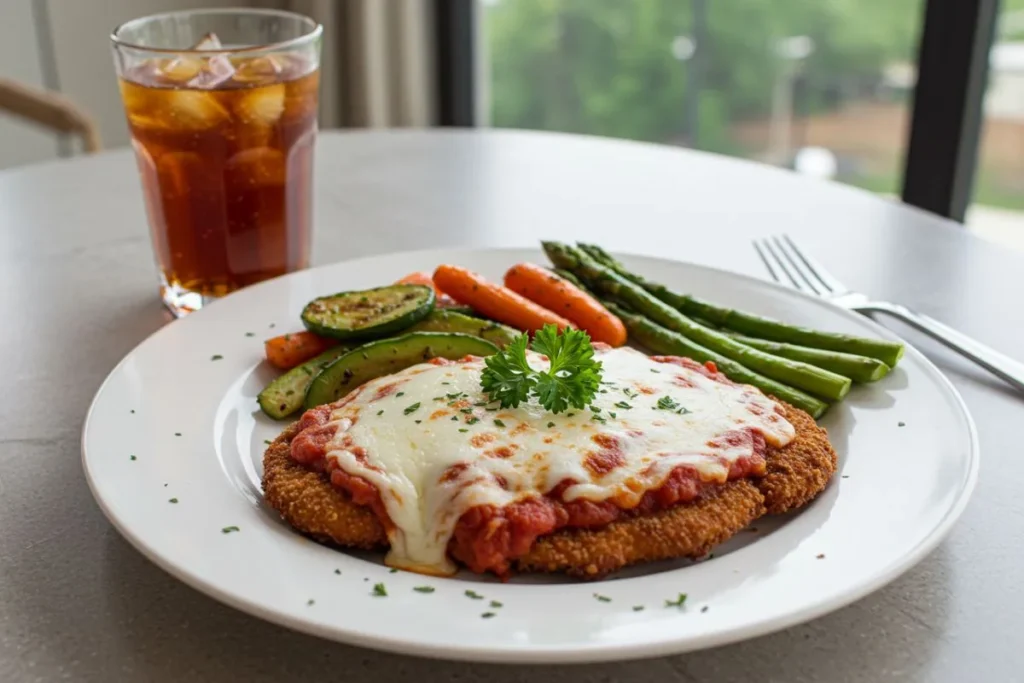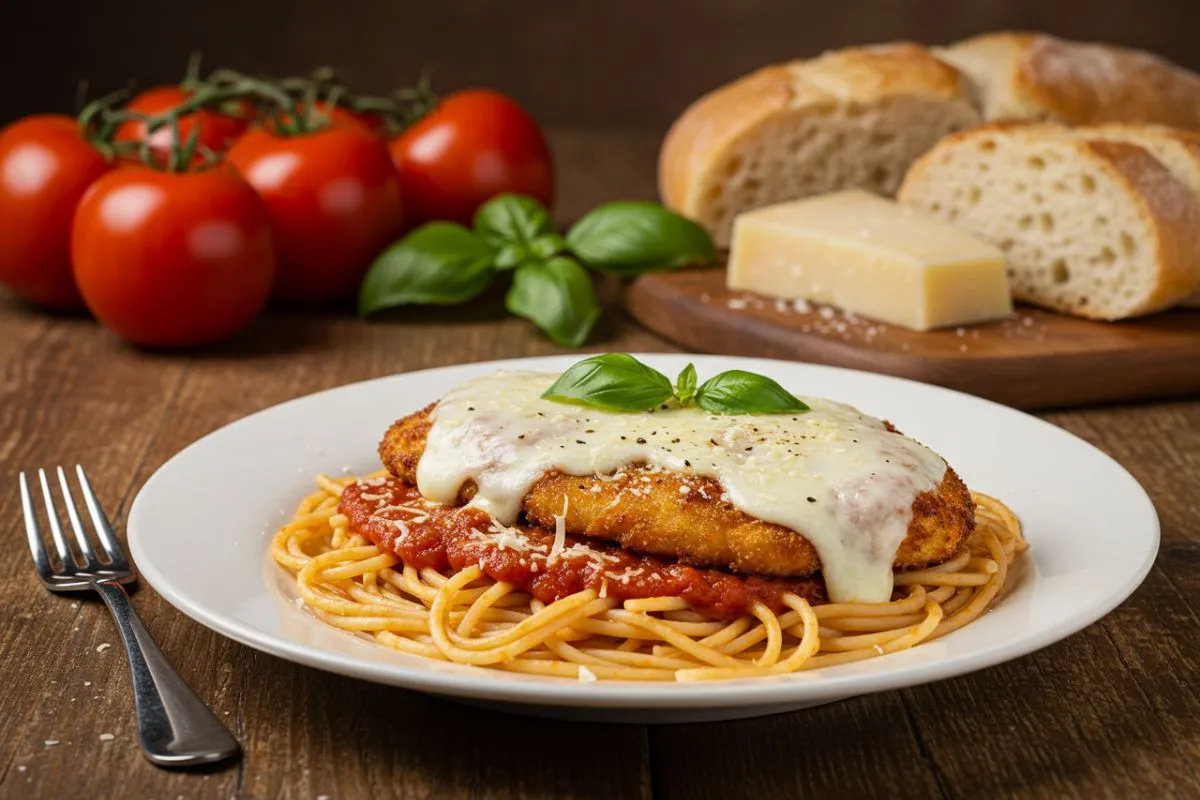Chicken parmigiana and chicken parmesan—two names, one iconic dish. Or are they? While these dishes seem synonymous, there are subtle distinctions tied to culture, preparation, and presentation. Both have roots in Italian cuisine but have evolved uniquely over time, particularly as they crossed into American kitchens.
In this article, we’ll uncover the origins of these dishes, explore the differences in their preparation and cultural significance, and debunk common misconceptions. By the end, you’ll not only know what is the difference between chicken parmigiana and chicken parmesan but also gain a deeper appreciation for this beloved classic.
The Origins and History of Chicken Parmigiana and Chicken Parmesan
A Look at Italian Roots
The story of chicken parmigiana begins in Italy, where eggplant parmigiana (parmigiana di melanzane) was a beloved dish. Made with layers of fried eggplant, tomato sauce, and cheese, this vegetarian staple inspired adaptations featuring other ingredients, including chicken. Italians traditionally relied on simple, fresh ingredients to create hearty yet elegant meals, and parmigiana was no exception.
However, the classic chicken parmigiana as we know it today doesn’t hail directly from Italy. Instead, it represents a melding of Italian flavors with American ingredients and cooking styles, as Italian immigrants brought their culinary traditions to the United States.
American Evolution: Enter Chicken Parmesan
Chicken parmesan emerged as a distinctly Italian-American creation. With access to larger cuts of meat and abundant cheese, Italian immigrants adapted the recipe to cater to local tastes. This evolution transformed parmigiana from a vegetarian casserole into a protein-rich entrée centered around breaded chicken.
The Americanized version also embraced heavier sauces and generous servings of melted cheese, often served alongside pasta—a pairing not common in traditional Italian cuisine. The dish became a hallmark of Italian-American restaurants, cementing its identity as chicken parmesan.
Differences in Preparation and Ingredients
How Chicken Parmigiana is Traditionally Prepared

Chicken parmigiana, rooted in Italian cuisine, prioritizes simplicity and authenticity. The dish often features lightly breaded and pan-fried chicken cutlets, smothered with tomato sauce and a light sprinkling of Parmesan or Pecorino cheese. It’s baked to meld the flavors, creating a perfectly balanced meal.
In traditional Italian cooking, olive oil is the preferred frying medium, and the tomato sauce is made from fresh, ripe tomatoes seasoned with garlic, basil, and oregano. Cheese is added sparingly to enhance the dish without overwhelming it.
The American Take: Chicken Parmesan
Chicken parmesan, inspired by its Italian roots, is a heavier dish. It has thicker breading, more mozzarella cheese, and a richer tomato sauce. Often, it’s deep-fried instead of pan-fried, making it even more indulgent.
A key difference lies in serving styles. Chicken parmesan is often paired with pasta in the United States—a combination that’s rarely seen in traditional Italian meals. This variation has made the dish a favorite in Italian-American restaurants.
Cultural and Regional Significance
Cultural Role in Italy
In Italy, chicken parmigiana is not as common as its eggplant counterpart, parmigiana di melanzane. This dish represents the country’s rich tradition of making the most of local, seasonal ingredients. Italians consider chicken parmigiana more of an “adopted dish,” shaped by immigrant communities abroad.
Popularity in the United States
Chicken parmesan became a key part of Italian-American cooking, growing with immigrant communities in cities like New York and Chicago. It shows how Italian recipes changed to match American tastes for bigger, more filling meals.
Today, the dish is a beloved comfort food, often featured on menus ranging from casual diners to upscale Italian eateries.
Variations of Chicken Parmigiana and Chicken Parmesan
Regional Variations in Italy
Chicken parmigiana isn’t a widely recognized staple in Italy, but local traditions have inspired variations. In southern regions like Campania and Sicily, eggplant parmigiana remains the classic dish, with chicken substitutions appearing only occasionally. When Italians do use chicken, they prepare it lightly, allowing it to complement the flavors of the main meal rather than dominate.
Simplicity defines the dish in these regions. Cooks use fresh mozzarella or Pecorino cheese sparingly, while the tomato sauce remains light and aromatic. These adaptations emphasize freshness and balance, staying true to the core principles of Italian cuisine rather than leaning toward indulgence. For more authentic Italian dishes and their origins, check out BBC Good Food’s guide to Italian classics.
American Restaurant Styles
In the U.S., chicken parmesan has become a signature menu item, with variations designed to cater to local tastes. Chain restaurants and pizzerias often serve the dish with spaghetti or fettuccine, creating a heartier meal. Upscale restaurants elevate the dish with touches like fresh burrata cheese or house-made marinara, drawing on the same bold flavors that define recipes like Garlic Parmesan Chicken Pasta.
Home cooks have also embraced the dish, experimenting with air-frying techniques to achieve crispy textures without excess oil. These adaptations showcase how chicken parmesan has evolved into a versatile and beloved recipe.
Misconceptions About Chicken Parmigiana and Chicken Parmesan
Is Chicken Parmigiana the Same as Chicken Parmesan?
One common question is, “What is the difference between chicken parmigiana and chicken parmesan?” The answer lies in their origins and preparation methods. While chicken parmigiana is rooted in Italian traditions, chicken parmesan is its heartier, Italian-American cousin.
Another misconception is that these dishes always come with pasta. In Italy, chicken parmigiana is often served as a standalone dish or with a light salad, while the American version frequently includes pasta as a side. This pairing reflects American preferences for larger, more filling meals.
Do Italians Eat Chicken Parmesan?
Though chicken parmesan is a popular dish in Italian-American cuisine, it’s not a traditional Italian staple. Italians are more likely to serve eggplant parmigiana or other vegetable-based versions of the dish. This difference highlights how Italian-American cuisine has adapted to its environment while staying connected to its roots.
The Role of Cheese and Sauce in Differentiating the Dishes
How Cheese Choices Define Each Dish
One of the key differences between chicken parmigiana and chicken parmesan lies in the choice of cheese. For instance, traditional chicken parmigiana often incorporates freshly grated Parmesan or Pecorino Romano cheese in small amounts, which helps to highlight its mild, nutty flavors. Moreover, Italian cooks tend to avoid using excessive amounts of cheese, as they aim to let the other ingredients shine through and maintain a harmonious balance of flavors.
In contrast, chicken parmesan, especially in American kitchens, leans heavily on mozzarella for its gooey, melty texture. Some versions even combine mozzarella with Parmesan or Provolone to create a richer, creamier topping. This style suits Americans’ love for rich, cheesy dishes.
The Sauce Spectrum
The tomato sauce shapes the unique character of chicken parmigiana and chicken parmesan. In traditional Italian cooking, chefs prepare the sauce fresh using crushed tomatoes, olive oil, and aromatic herbs like basil, oregano, and garlic. This light, vibrant sauce boosts the chicken’s natural flavor without overwhelming it. Italians focus on balance, letting the dish’s simplicity and freshness shine. For more tips on creating balanced and tasty meals, visit MyPlate.gov.
In contrast, chicken parmesan in the United States takes a bolder approach. Cooks typically use thicker sauces made with canned marinara or tomato puree, seasoned heavily to match American tastes. They often add sugar or honey to create a sweeter profile, which complements the richer flavors of the cheese and breading. This style matches American preferences for rich, filling meals that please both the stomach and the palate.
The sauce doesn’t just influence flavor—it also affects texture and presentation. Italian-style sauce is Lightly spooned over the chicken., allowing the crisp breading to stay intact. On the other hand, the American version often includes a thick layer of marinara that covers the chicken in a blanket of sauce and cheese. This approach creates a gooey, comforting dish, perfect for pairing with pasta or crusty bread.
Whether light and fresh or thick and hearty, the sauce transforms chicken parmigiana and chicken parmesan into uniquely delicious experiences. Chefs and home cooks continue to adapt the sauce to their preferences, making these meals timeless and flexible.
Frequently Asked Questions (FAQs)
What is the Difference Between Chicken Parmigiana and Chicken Parmesan?
Chicken parmigiana, inspired by Italian tradition, highlights simple and balanced flavors. Chicken parmesan, its Italian-American version, is richer with heavier sauces and extra cheese.
Do Italians Eat Chicken Parmigiana or Chicken Parmesan?
Italians rarely eat chicken parmigiana as it’s known in the U.S. Instead, they prefer eggplant parmigiana. Chicken parmigiana exists mainly as an adaptation by Italian immigrants in America.
Which Cheese is Better for Chicken Parmigiana?
For authenticity, freshly grated Parmesan or Pecorino Romano is ideal. However, mozzarella is often added for a gooey texture, especially in the Americanized version.
Why is Chicken Parmesan Often Served with Pasta?
In the U.S., serving chicken parmesan with pasta creates a complete, hearty meal. This combination is rare in Italy, where meals are usually simpler and lower in carbs.
Modern Takes on Chicken Parmigiana and Chicken Parmesan
Creative Restaurant Variations
In recent years, chefs around the world have created new versions of chicken parmigiana and chicken parmesan. Fancy restaurants often add gourmet touches that highlight modern cooking creativity. For instance, instead of traditional tomato sauce, some chefs use sun-dried tomato pesto or roasted red pepper coulis to create a unique flavor profile. Adding a drizzle of balsamic reduction or pairing the dish with seasonal roasted vegetables like charred Brussels sprouts or heirloom carrots also brings a refined edge.
Modern restaurants have come up with fun, creative twists on chicken parmesan. Some turn it into chicken parmesan pizza, with breaded chicken, marinara, and mozzarella on a crispy pizza crust. Others make sliders, using small pieces of breaded chicken in soft brioche buns with fresh basil and melted cheese. These creative versions keep the classic flavors alive while making them exciting for a new generation of food lovers.
Fusion cuisines have also added their own spin to chicken parmesan. Some chefs mix Asian spices into the breading or use Japanese panko crumbs for extra crunch. These changes show how easily the dish can be customized and how it evolves with global food trends.
Home Cooks and Dietary Adaptations

Home cooks have also found creative ways to remake chicken parmigiana and chicken parmesan. Healthier cooking methods like air-frying have become popular, cutting down on oil while keeping the chicken crispy. This technique works especially well for breaded chicken, creating a lighter but still delicious version of the dish. This technique works especially well for breaded chicken, creating a lighter but still delicious version of the dish. If you’re curious about the health benefits of air-frying, visit Hopkins Medicine’s air-fryer guide.
Dietary changes have become common, letting more people enjoy this classic dish. Gluten-free versions often use almond flour, coconut flour, or even crushed pork rinds in place of traditional breadcrumbs. People on a keto diet might skip the breading altogether and bake chicken breasts topped with marinara and cheese for a low-carb alternative. Even plant-based diets can embrace the essence of these dishes, using breaded cauliflower or tofu as a protein substitute.
For those looking to cut down on carbs, zucchini noodles, spaghetti squash, or cauliflower rice make excellent replacements for pasta. These swaps maintain the dish’s comforting essence while making it lighter and packed with nutrients
Whether in restaurants or home kitchens, these changes bring fresh ideas to chicken parmigiana and chicken parmesan, showing their lasting popularity and flexibility.
For another creative take on comfort food, explore our Sweet Hawaiian Crockpot Chicken, a perfect dish for family dinners.
Final Thoughts on What is the Difference Between Chicken Parmigiana and Chicken Parmesan?
The question, “What is the difference between chicken parmigiana and chicken parmesan?” reveals that both dishes share the same origins but have developed in different ways. Chicken parmigiana showcases the simple and fresh flavors of Italian cooking. In contrast, chicken parmesan highlights the rich, bold style of Italian-American cuisine.
Whether you prefer the light touch of an Italian-style chicken parmigiana or the hearty comfort of an American chicken parmesan, both versions offer a delicious way to celebrate this timeless dish. From traditional recipes to modern twists, these dishes have something for everyone.
Next time you’re in the kitchen, why not experiment with both styles? You can explore the authentic Italian approach for a special dinner or embrace the cheesy, saucy American version for a comforting weeknight meal.
For more recipe inspiration, including creative uses of Parmesan cheese, explore our Garlic Parmesan Chicken Pasta recipe. It’s another great way to enjoy these beloved flavors.

